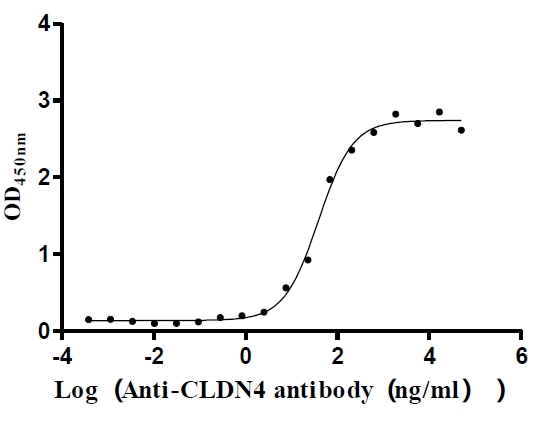Recombinant Human Ubiquitin carboxyl-terminal hydrolase 14 (USP14)
-
中文名稱:人USP14重組蛋白
-
貨號:CSB-YP025704HU
-
規格:
-
來源:Yeast
-
其他:
-
中文名稱:人USP14重組蛋白
-
貨號:CSB-EP025704HU-B
-
規格:
-
來源:E.coli
-
共軛:Avi-tag Biotinylated
E. coli biotin ligase (BirA) is highly specific in covalently attaching biotin to the 15 amino acid AviTag peptide. This recombinant protein was biotinylated in vivo by AviTag-BirA technology, which method is BriA catalyzes amide linkage between the biotin and the specific lysine of the AviTag.
-
其他:
-
中文名稱:人USP14重組蛋白
-
貨號:CSB-BP025704HU
-
規格:
-
來源:Baculovirus
-
其他:
-
中文名稱:人USP14重組蛋白
-
貨號:CSB-MP025704HU
-
規格:
-
來源:Mammalian cell
-
其他:
產品詳情
-
純度:>85% (SDS-PAGE)
-
基因名:USP14
-
Uniprot No.:
-
別名:Deubiquitinating enzyme 14; TGT; tRNA guanine transglycosylase 60 kD subunit; tRNA guanine transglycosylase; Ubiquitin carboxyl terminal hydrolase 14; Ubiquitin carboxyl-terminal hydrolase 14; Ubiquitin specific peptidase 14; Ubiquitin specific processing protease 14; Ubiquitin specific protease 14; Ubiquitin thiolesterase 14; Ubiquitin-specific-processing protease 14; UBP14_HUMAN; USP 14; USP14
-
種屬:Homo sapiens (Human)
-
蛋白長度:Full length protein
-
表達區域:1-494
-
氨基酸序列MPLYSVTVKW GKEKFEGVEL NTDEPPMVFK AQLFALTGVQ PARQKVMVKG GTLKDDDWGN IKIKNGMTLL MMGSADALPE EPSAKTVFVE DMTEEQLASA MELPCGLTNL GNTCYMNATV QCIRSVPELK DALKRYAGAL RASGEMASAQ YITAALRDLF DSMDKTSSSI PPIILLQFLH MAFPQFAEKG EQGQYLQQDA NECWIQMMRV LQQKLEAIED DSVKETDSSS ASAATPSKKK SLIDQFFGVE FETTMKCTES EEEEVTKGKE NQLQLSCFIN QEVKYLFTGL KLRLQEEITK QSPTLQRNAL YIKSSKISRL PAYLTIQMVR FFYKEKESVN AKVLKDVKFP LMLDMYELCT PELQEKMVSF RSKFKDLEDK KVNQQPNTSD KKSSPQKEVK YEPFSFADDI GSNNCGYYDL QAVLTHQGRS SSSGHYVSWV KRKQDEWIKF DDDKVSIVTP EDILRLSGGG DWHIAYVLLY GPRRVEIMEE ESEQ
-
蛋白標簽:Tag?type?will?be?determined?during?the?manufacturing?process.
The tag type will be determined during production process. If you have specified tag type, please tell us and we will develop the specified tag preferentially. -
產品提供形式:Lyophilized powder
Note: We will preferentially ship the format that we have in stock, however, if you have any special requirement for the format, please remark your requirement when placing the order, we will prepare according to your demand. -
復溶:We recommend that this vial be briefly centrifuged prior to opening to bring the contents to the bottom. Please reconstitute protein in deionized sterile water to a concentration of 0.1-1.0 mg/mL.We recommend to add 5-50% of glycerol (final concentration) and aliquot for long-term storage at -20℃/-80℃. Our default final concentration of glycerol is 50%. Customers could use it as reference.
-
儲存條件:Store at -20°C/-80°C upon receipt, aliquoting is necessary for mutiple use. Avoid repeated freeze-thaw cycles.
-
保質期:The shelf life is related to many factors, storage state, buffer ingredients, storage temperature and the stability of the protein itself.
Generally, the shelf life of liquid form is 6 months at -20°C/-80°C. The shelf life of lyophilized form is 12 months at -20°C/-80°C. -
貨期:Delivery time may differ from different purchasing way or location, please kindly consult your local distributors for specific delivery time.Note: All of our proteins are default shipped with normal blue ice packs, if you request to ship with dry ice, please communicate with us in advance and extra fees will be charged.
-
注意事項:Repeated freezing and thawing is not recommended. Store working aliquots at 4°C for up to one week.
-
Datasheet :Please contact us to get it.
相關產品
靶點詳情
-
功能:Proteasome-associated deubiquitinase which releases ubiquitin from the proteasome targeted ubiquitinated proteins. Ensures the regeneration of ubiquitin at the proteasome. Is a reversibly associated subunit of the proteasome and a large fraction of proteasome-free protein exists within the cell. Required for the degradation of the chemokine receptor CXCR4 which is critical for CXCL12-induced cell chemotaxis. Serves also as a physiological inhibitor of endoplasmic reticulum-associated degradation (ERAD) under the non-stressed condition by inhibiting the degradation of unfolded endoplasmic reticulum proteins via interaction with ERN1. Indispensable for synaptic development and function at neuromuscular junctions (NMJs). Plays a role in the innate immune defense against viruses by stabilizing the viral DNA sensor CGAS and thus inhibiting its autophagic degradation.
-
基因功能參考文獻:
- By displacing USP14, TRIM11 changes proteasome composition and suppresses both catalytic and non-catalytic effects of USP14 PMID: 29581427
- Usp14 and Ube3c cycle together on and off proteasomes, and the presence of ubiquitinated substrates promotes their association. This mechanism enables proteasome activity to adapt to the supply of substrates. PMID: 28396413
- Study detected elevated USP14 expression at both mRNA and protein levels, and was significantly associated with distant metastasis. PMID: 28509417
- These findings suggested that USP14 induces NF-kappaB activity and ERK1/2 phosphorylation triggered by microbial infection. PMID: 28364380
- Ubiquitin-specific protease 14 regulates cell proliferation and apoptosis in oral squamous cell carcinoma PMID: 27592452
- our report demonstrates significant value in targeting USP14/UCHL5 with VLX1570 in drug-resistant Waldenstrom macroglobulinemia (WM) and carries a high potential for clinical translation PMID: 27813535
- USP14 promotes prostate cancer progression. PMID: 28151478
- without a ubiquitinated substrate present, Usp14 suppresses multiple proteasomal activities, especially basal ATP consumption and degradation of non-ubiquitinated proteins. These allosteric effects thus reduce ATP hydrolysis by inactive proteasomes and nonspecific proteolysis and enhance proteasomal specificity for ubiquitinated proteins. PMID: 28416611
- USP14 regulates autophagy by negatively controlling K63 ubiquitination of Beclin 1 PMID: 27542828
- USP14 plays an important role in the progression and metastasis of esophageal squamous cell carcinoma. PMID: 27629392
- USP14 participates in CAM-DR of MM through acting as a bridge between Bcl-xl apoptotic pathway and Wnt-signaling pathways and may be represented as a good candidate for pursuing clinical trials in MM. PMID: 26710889
- Results show that USP14 mRNA is overexpressed in hepatocellular carcinoma (HCC) tissues and inversely correlates with miR-4782-3p level which binds to USP14 3'UTR to regulate its expression. PMID: 26782643
- Results found USP14 amplification and overexpression in many different cancers. Its overexpression in low-expression cell lines promoted cell proliferation and migration, whereas its downregulation suppressed tumor cell proliferation, increased apoptosis rate, and decreased cell migration and invasion suggesting an oncogenic role in various types of cancer. PMID: 26938858
- Increased USP14 expression in patients with breast cancer was associated with a poorer prognosis. PMID: 26712154
- Akt-mediated phosphorylation of USP14 at Ser432, which normally blocks its catalytic site in the inactive conformation, activates its deubiquitinating activity in vitro and in cells. PMID: 26523394
- our findings suggested that USP14 is involved in the progression of hepatocellular carcinoma(HCC) and may be a useful therapeutic target in HCC PMID: 26397990
- Cell surface ubiquitination precedes endocytosis, after which USP14 acts as an ubiquitin-binding protein that targets the ubiquitinated GABA B receptor to lysosomal degradation and promotes its deubiquitination. PMID: 26817839
- USP14 shows a marked preference for ubiquitin-cyclin B conjugates that carry more than one ubiquitin modification or chain PMID: 27074503
- our findings suggest that USP14 is involved in the progression of epithelial ovarian cancer PMID: 25429837
- Downregulation of USP14 expression arrested the cell cycle, which may be related to beta-catenin degradation. PMID: 23702845
- b-AP15 is an inhibitor of deubiquitylating enzyme USP14 and UCHL5 induces apoptosis in multiple myeloma and overcomes bortezomib resistance. PMID: 24319254
- overexpression of HA-USP14 increased the LPS-, TNFalpha-, or Escherichia coli-induced IL-8 release in human lung epithelial cells. PMID: 23615914
- the decrease in proteolysis of proteasomal substrates during aging is independent of the increased USP14 activity and that the reciprocal regulation of USP14 and proteasomal catalytic activity may be necessary to maintain cellular ubiquitin homeostasis. PMID: 23291607
- High Ubiquitin-specific protease 14 expression associated with intrahepatic cholangiocarcinoma cell differentiation. PMID: 21627382
- the catalytic cleft leading to the active site of USP14 is blocked by two surface loops. Binding by ubiquitin induces a significant conformational change thereby allowing access of the ubiquitin C-terminus to the active site. PMID: 16211010
- Results show the overall survival rate was worse in patients with a high USP14/TGT60 kD expression level and suggest that USP14/TGT60 kD also controls the fate of proteins that regulate tumor invasion and metastasis. PMID: 16465409
- Neuronal expression of full-length USP14 is able to restore the levels of monomeric ubiquitin in the brains of transgenic ataxia mice. PMID: 17079671
- USP14 were over-expressed in ovarian serous cystadenocarcinoma tissues, suggesting that the activity of ubiquitin-proteasome system is obviously enhanced in ovarian cancer. PMID: 17553343
- These findings suggest that USP14 is a novel player in the unfolded protein response by serving as a physiological inhibitor of ER-associated degradation under the non-stressed condition. PMID: 19135427
- Data from transgenic mice define a critical role for Usp14 at mammalian synapses and suggest a requirement for local ubiquitin recycling by the proteasome to control the development and function of neuromuscular junctions. PMID: 19726649
顯示更多
收起更多
-
亞細胞定位:Cytoplasm. Cell membrane; Peripheral membrane protein.
-
蛋白家族:Peptidase C19 family, USP14/UBP6 subfamily
-
數據庫鏈接:
Most popular with customers
-
Recombinant Human Glypican-3 (GPC3) (G537R), partial (Active)
Express system: Mammalian cell
Species: Homo sapiens (Human)
-
Recombinant Mouse Tyrosine-protein kinase Mer (Mertk), partial (Active)
Express system: Mammalian cell
Species: Mus musculus (Mouse)
-
Recombinant Mouse Claudin-18.2 (Cldn18.2)-VLPs (Active)
Express system: Mammalian cell
Species: Mus musculus (Mouse)
-
Recombinant Human Claudin-4 (CLDN4)-VLPs (Active)
Express system: Mammalian cell
Species: Homo sapiens (Human)
-
Recombinant Human C-C chemokine receptor type 9 (CCR9)-VLPs (Active)
Express system: Mammalian cell
Species: Homo sapiens (Human)
-
Recombinant Human C-C chemokine receptor type 5 (CCR5)-VLPs (Active)
Express system: Mammalian cell
Species: Homo sapiens (Human)
-
Recombinant DT3C (Diphtheria toxin & spg 3C domain) for Antibody Internalization Assay (Active)
Express system: E.coli
Species: N/A


-AC1.jpg)

-AC1.jpg)













